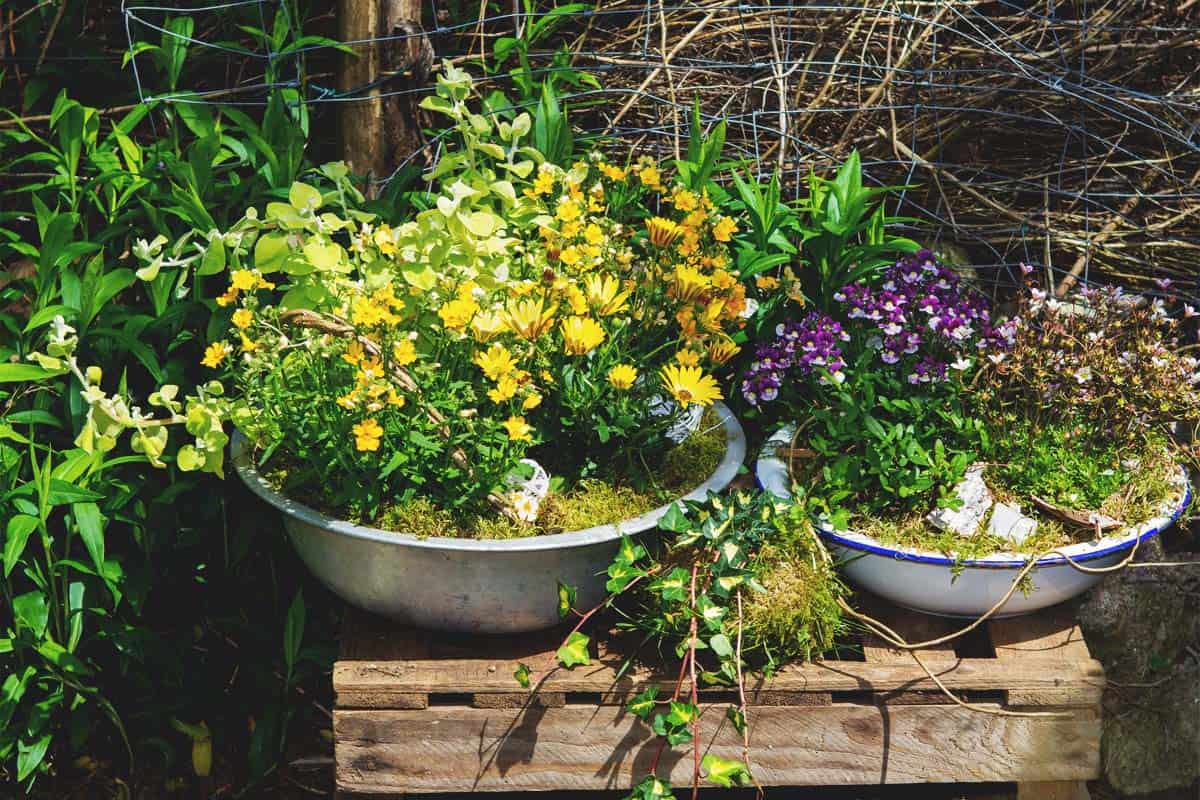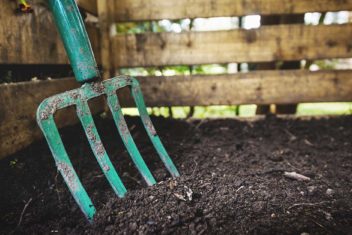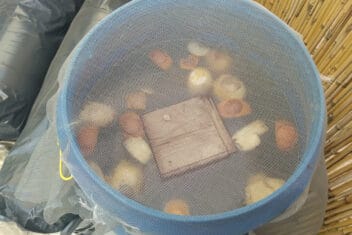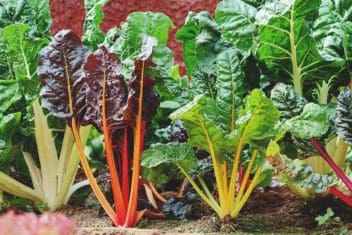You spent all growing season loving and caring for your perennial container garden. That takes a lot of work and dedication. Chances are you want to learn how to overwinter perennials growing in containers – after all, you don’t want all that hard work go to waste.
Some gardeners treat perennials like annuals, tossing them out after the end of the growing season, but that’s truly a loss. Not only is it a waste of money, but perennials tend to come back fuller and heartier each year, producing stronger blossoms and fruits the second and third year.
If tossing perennials feels like blasphemy, you have a few choices. You can overwinter in containers or transplant into your garden beds for the winter.
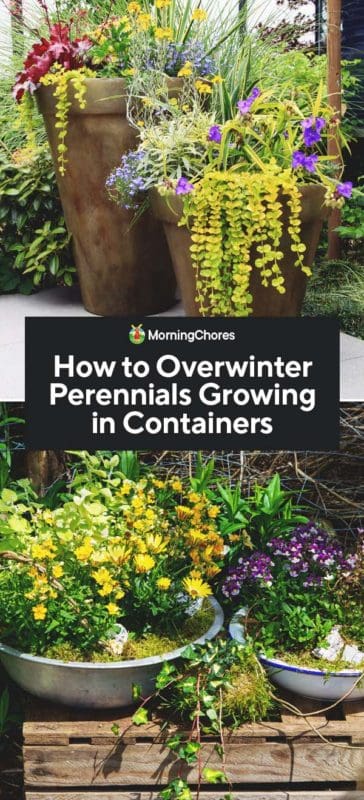
Why You Should Overwinter Perennials in Containers
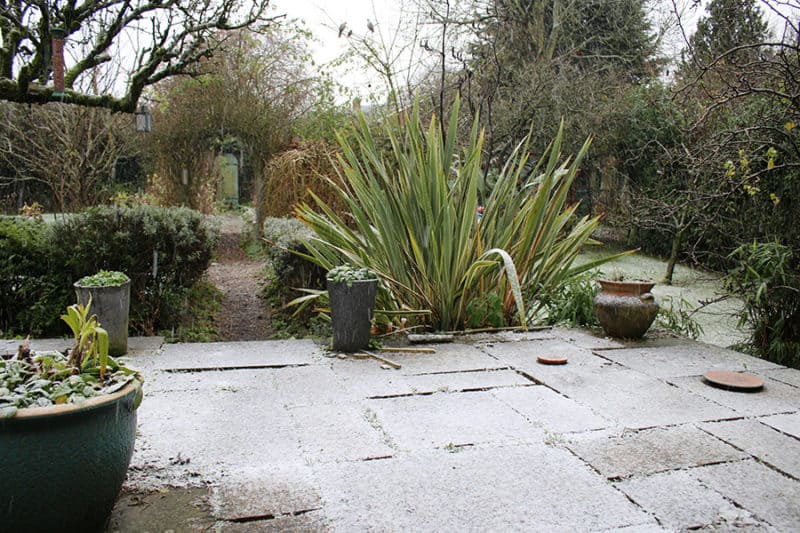
Even if you picked perennials that are hardy to your zone, perennials in containers are subject to harsher winter conditions than those perennials planted in the ground. The root system is in a pot rather than inside of the ground, which exposes them to freezing air temperatures and drying winds. Those conditions can damage the root system.
Perennial plants have roots that sleep until next spring. Many of your favorite plants are perennials, such as hostas, daylilies, and astilbe. The goal of overwintering perennial plants is to keep the plants dormant and create the right environment for your hardiness zone.
A few other reasons that you want to overwinter your perennials include:
- Soil heaving takes place when the soil freezes and thaws repeatedly. That can cause the roots to break up and move up from the earth, leaving plants more vulnerable.
- Temperatures fluctuate more above ground than in the ground. Perennials aren’t a fan of significant temperature fluctuations; they prefer gradual changes or a consistent temperature.
How to Overwinter Perennials Growing in Containers
There are a few methods that you can use to get your beloved perennials through the winter undamaged. The spring might seem like ages away, but your plants only need to survive a few months. After a few killing touches of frost, water your plants thoroughly and pick a method for overwintering.
Pick the Right Container
Planning makes perfect, especially for gardening. You should know ahead of time if you plan to overwinter your plants in their containers. That allows you to pick the right container in the correct size if you plan to leave them outside all winter.
You want a container that won’t break from the freezing and thawing cycle. Clay, glazed, and porcelain pots are all susceptible to breaking in the winter, so you need to stay clear of them. While you might get lucky, I wouldn’t risk it, mainly because these pots tend to cost more money.
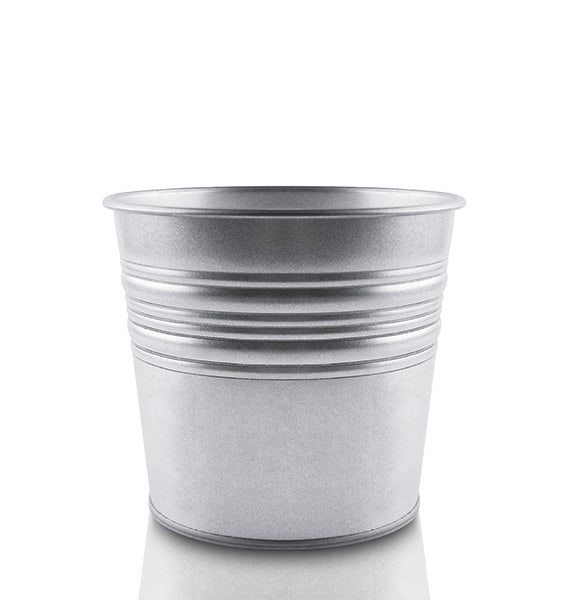
Instead, go for containers that are meant to be left outside. Plastic, composite, metal, and wood pots are all excellent choices for overwintering perennials in containers. They can handle the expanding and contrasting soil as the temperatures fluctuate.
Do Nothing
The first thing you could do is nothing. Leave your potted perennial plant where it is outside. If you have a large enough container that can withstand the elements, your plants might stand a chance. A large container holds more soil, which helps to insulate the root system and keep soil temperatures consistent.
This only works if your plant is at least two zones hardier than your area. That means if you live in USDA Zone 5, such as I do, then you need to put perennials in your containers that are hardy to Zone 3 or lower. Doing so increases the chances of successfully overwintering your plants.
Be sure to keep the containers away from areas that receive sunlight. If sunlight touches the side of the container, it can warm up the soil, leading to the freezing and thawing cycle that can trigger early growth. You don’t want your plants to think that its spring when its just a warm day in January.
Store Your Perennials Indoors
If you have an unheated garage, shed, or basement that has temperatures between 30-40℉, you have the perfect environment for overwintering perennials in containers. You can bring your dormant plants inside. Make sure to water them periodically whenever the temperatures go above 40℉.
Since the plants are in dormancy, they don’t need light for photosynthesis, but you do need to check to make sure the soil doesn’t become too dry. At the same time, avoid overwatering because it can cause plants to rot or break dormancy.
In late winter or early spring, it’s time for your plants to break dormancy. Reintroduce your plants to normal growing conditions by gradually exposing it to the elements again for increasing periods. This process is similar to hardening off that you do with seedlings.
Bury the Containers In the Soil
Not everyone has an appropriate indoor area to bring their perennials, but you aren’t out of luck if you don’t. Keep those perennials in their pots and dig a hole large enough to hold the entire container. Place the perennials in the hole until they’re the same level as the rest of the ground.
This method works because it helps to protect your delicate root systems. Placing the container in the ground helps to moderate the temperature around the roots, avoiding excessive freezing and thawing.
Remember that this method only works if you have perennial plants that are hardy in your USDA hardiness zone. A tropical plant won’t survive the winter in Zone 5 just because you buried it in the ground.
Plant in Your Garden Bed
Instead of burying the entire pot, you can remove the plant from its container and replant the perennials into your garden beds. It does the same thing as burying the pot; it helps to insulate the root system and protect it from the frigid temperatures.
You’ll need to dig up the plants in the early spring and return them to a container. If you decide that you like your perennial in the garden beds, you could leave it there, or take a cutting and start a new potted plant.
Protect Your Containers Outside
If you cannot dig into the ground, the next method is to group the containers together and place them in a protected area. The area needs to be out of strong winds and intense sunlight. You can surround the containers with straw, leaves, or bark mulch.
You can continue to water the pots until the soil freezes and as long as the temperatures don’t go above 40℉. With the proper protection, your perennials will survive until spring.
For the Non-Dormant Perennials
Some perennial plants don’t require a dormant period, and that can mess up all of your plans for overwintering. While these aren’t the focus of this guide, I did want to point out that some plants are like this.
In these cases, it’s best to move the plants indoors to a warm, bright sunny windowsill that faces east, south, or west. Make sure you water regularly and turn the plant every week or so to prevent a curved stem that is facing toward the winter.
Care Considerations When Overwintering Perennials
You know that you have to water perennials throughout dormancy, but it’s not frequent. There are a few other care considerations that you need to remember when you learn how to overwinter perennials growing in containers.
- If you plan to overwinter your plants inside, you need to use pruning shears to cut back to four to six inches above the crown.
- Don’t fertilize your dormant plants. When the active growing period stoops in the fall, stop fertilizing, but you should continue to water when the soil is dry.
- Monitor the moisture level and water if it feels dry. Perennial plants that get completely dry can die of desiccation, which is the removal of moisture.
- Keep the container in a location where it can drain freely. You might want to use pot feet or a pallet to keep it raised off of the ground. Pots sitting in a puddle of water leads to soggy soil.
- The more soil in the pot, the better insulated the roots will be from the weather. Instead of swapping pots, you can put your existing container into a larger pot and fill the sides with mulch or soil. Either way helps to add extra protection around the roots.
Perennial Plants that Overwinter Well in Containers
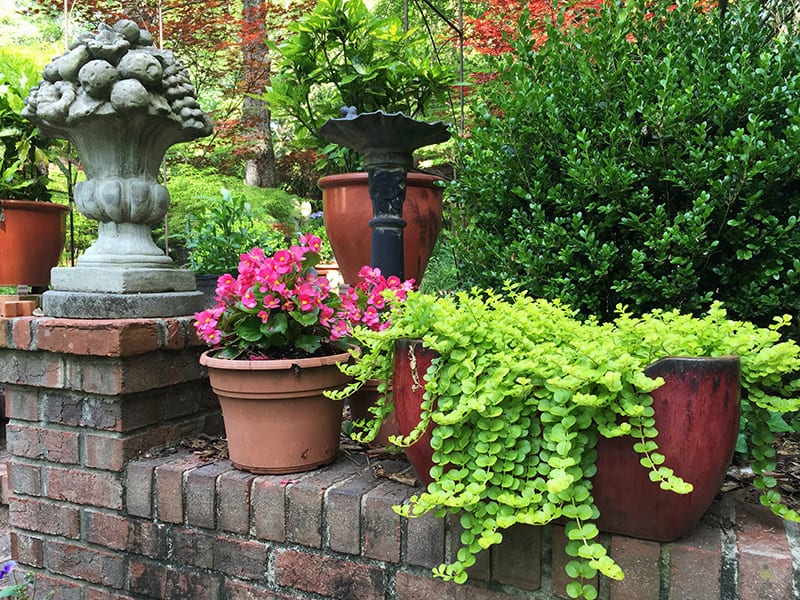
Not all perennials grow well in containers, and not all handle overwintering in containers. If your goal for your container garden is to do so, make sure you plant the right plants.
Here are a few plants to consider.
- Yarrow
- Lady’s Mantle
- Aster
- Brunnera
- Clematis
- Dianthus
- Echinacea
- Ferns
- Heuchera
- Hosta
- Spiderwort
- Foamflower
- Pincushion Flower
- Jacob’s Ladder
- Creeping Phlox
- Creeping Jenny
- Japanese Iris
- Primrose
Try Overwintering Perennials
Perennials can last for years to come, and you will be able to take cuttings and distribute them to friends and family over the years. If you want your perennials to survive all year long, you have to learn how to overwinter perennials growing in containers. You have several options to consider; it’s not as hard as you might think!
